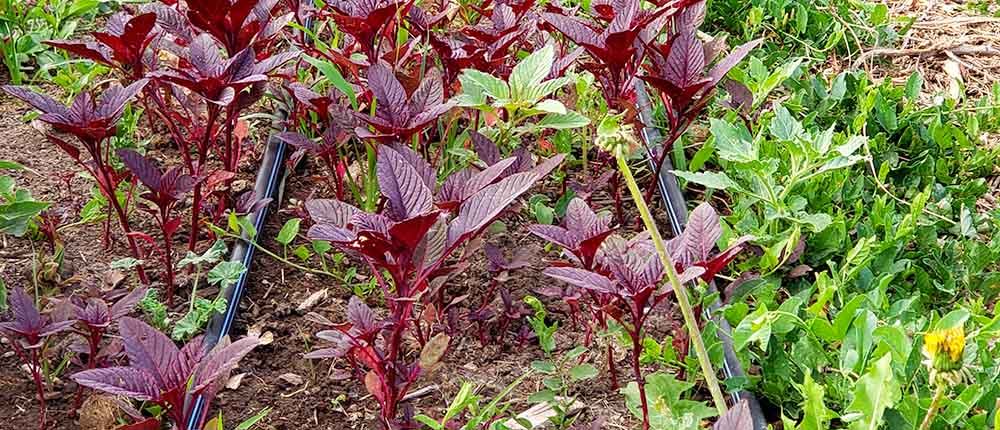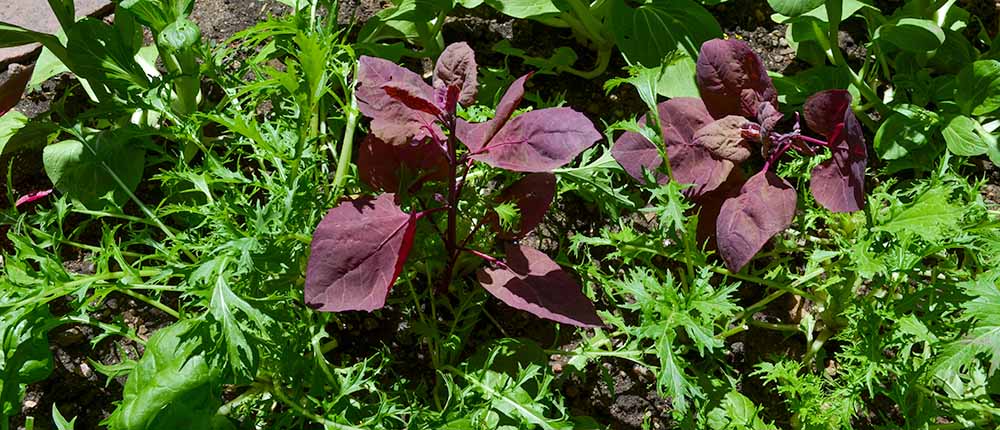Heat-Tolerant Greens
to Reimagine Your Summer Table
There’s an easy-growing secret waiting to be discovered in your backyard this summer – heat-tolerant greens.
These unique varieties thrive in hot weather, offering a continuous harvest of flavorful leaves long after traditional cool-season greens have stopped producing. They can bring diversity to your plate and add crisp freshness to your meals, making them the key to a garden-fresh salad season this summer.
Heat-tolerant greens provide an extended harvest with distinctive flavors and textures, going beyond the usual lettuce, kale, and spinach.
From the slightly earthy flavor of Red Aztec Spinach to the peppery tang of Malabar Spinach and the tender, spinach-like leaves of Red Orach, these greens can add depth and flavor to your summer salads and fresh dishes, offering a world of possibilities.
Red Aztec Spinach, known as Huauzontle in Mexico, is a versatile green that flourishes in warm weather. Its tender leaves and stems offer a rich spinach flavor, making it a welcome addition to raw and cooked dishes. Some people compare the flavor to young broccoli rabe. Perhaps most intriguing are its unique seed heads, which resemble miniature broccoli florets and offer a delightful crunch and mild flavor.
To make the most of this heat-loving green, harvest the youngest leaves for salads, where their tender texture and mild flavor truly shine. As the leaves mature, they develop a deeper taste, perfect for sautéing with garlic and olive oil or adding depth to soups and stews.
The key is to harvest regularly, as this encourages the plant to produce new growth and prevents it from prematurely bolting.
If you have an abundance of this versatile green, consider adding it to quiches, frittatas, or even traditional Mexican dishes like “Tortitas de Huauzontles,” where the tender leaves and stems are cooked into patties and served with a flavorful slow-simmered tomato-based sauce. With its unique flavor and kitchen adaptability, Red Aztec spinach will surely become a beloved staple in your summer garden.
Malabar Spinach, also known as Basella rubra, thrives in hot climates. Its succulent leaves offer a slightly tangy and peppery flavor with a hint of citrus, adding a delightful zest to summer salads.
To harvest, snip individual leaves or the tips of the vines, being careful not to remove too much at once as this can weaken the plant. Regular harvesting actually encourages bushier growth and ensures a continuous supply of fresh leaves throughout the summer months.
Malabar spinach is a versatile ingredient with a wide range of uses in the kitchen. In Indian and Southeast Asian cuisine, it is commonly added to curries and soups for its thickening properties and unique flavor. It can also be stir-fried with other vegetables and spices for a quick and tasty side dish. The tender young leaves and shoots can be enjoyed raw in salads. Whether you’re looking for a flavorful addition to your summer cooking or a beautiful and functional vine for your garden, Malabar spinach is a heat-loving plant that won’t disappoint.
Amaranth, also known as Amaranthus hybridus, is a powerhouse in the garden, offering beautiful foliage, edible leaves, and nutritious seeds. The leaves have an earthy, slightly peppery flavor reminiscent of spinach. Young, tender leaves are a colorful addition to salads. However, the amaranth plant’s real star might be its seeds. These tiny grains boast a nutty flavor with impressive nutrition, making them a popular gluten-free alternative to traditional grains.
We offer Hopi Red Dye Amaranth.
To enjoy all of Amaranth’s offerings, start by harvesting young leaves for salads or microgreens. As the plant matures, you can gather the larger leaves for cooking, using them in stir-fries, soups, or as a side dish. Keep an eye on the seed heads in late summer or fall, harvesting them once they are dry and mature.
Amaranth greens can be prepared in many ways, such as sautéed with garlic and olive oil, steamed as a simple side dish, or added to soups for flavor. On the other hand, the seeds can be cooked like quinoa, popped like popcorn for a healthy snack, or ground into flavorful flour. This flour can then be used to create gluten-free breads, tortillas, and other baked goods, adding a unique nutty flavor and a boost of protein and fiber to your diet. With its abundance of nutrients and versatility in the kitchen, amaranth is a gift that keeps giving.
New Zealand Spinach (Tetragonia tetragonioides) is a unique green that thrives in hot weather, making it a valuable addition to the summer garden. Its mild, slightly salty flavor and distinct succulent texture add a delightful crunch to salads.
Regular harvesting is key to maintaining a productive plant. Pinch off individual leaves or tips of stems, being careful not to remove too much foliage at once, as this can stress the plant. Younger leaves are tender and perfect for adding a fresh, slightly salty note to salads, while older leaves are ideal for cooking.
Its sturdy leaves can substitute for spinach in soups, stews, stir-fries, frittatas, and omelets. Its unique texture and flavor also lend themselves well to creative dishes. The slightly salty flavor pairs beautifully with strong flavors like garlic, lemon, and chili peppers for unforgettable dishes. Whether you’re a seasoned cook or a novice gardener, New Zealand spinach is a must-try for anyone looking for a heat-tolerant and delicious alternative to traditional summer greens.
Red Orach (Atriplex hortensis), Mountain Spinach, or French Spinach, is a visually lovely green that thrives in hot weather. Its tender leaves offer a spinach-like flavor with a subtle saltiness and a hint of mineral tang. The smooth texture of the leaves makes it a delectable addition to salads and cooked meals. But it’s not just the taste that sets Red Orach apart – its vibrant red, pink, or purple stems add a pop of color to any plate, making it a feast for the eyes and the tastebuds.
Harvest regularly when they are young and tender to enjoy the freshest and most flavorful leaves. As the leaves mature, they can still be harvested for cooking, like spinach.
Red Orach effortlessly transitions from garden to table. Its vibrant leaves add a pop of color and a hint of saltiness to mixed green salads. You can also cook it like spinach, sauté it with garlic and olive oil, steam it as a simple side dish, or add it to soups and stews for added depth and nutrition. With its versatility, beauty, and resilience in hot weather, Red Orach is a true gem for any summer garden.
The world of heat-tolerant greens is a goldmine of flavors and textures waiting to be explored. Grow these often overlooked varieties in your garden, extending your harvest season and unlocking new possibilities in your kitchen. Imagine savoring fresh, vibrant salads bursting with unique flavors even as the summer sun beats down. From the peppery kick of Red Orach to the mild sweetness of Malabar spinach, the succulent crunch of New Zealand spinach to the deep richness of Amaranth, there’s a heat-tolerant green to suit every taste.
Don’t let the summer heat dictate your salad days! Take up the summer salad challenge and experiment with these deliciously resilient greens. Discover your personal favorites, and get creative in the kitchen. Toss them into salads, stir-fries, soups, and stews, or enjoy them sauteed with a drizzle of olive oil and a sprinkle of sea salt. By diversifying your garden and plate with these remarkable greens, you’ll beat the heat and elevate your summer meals to new heights of flavor. Let your garden showcase the joy of homegrown food, even in the face of challenging weather conditions.






